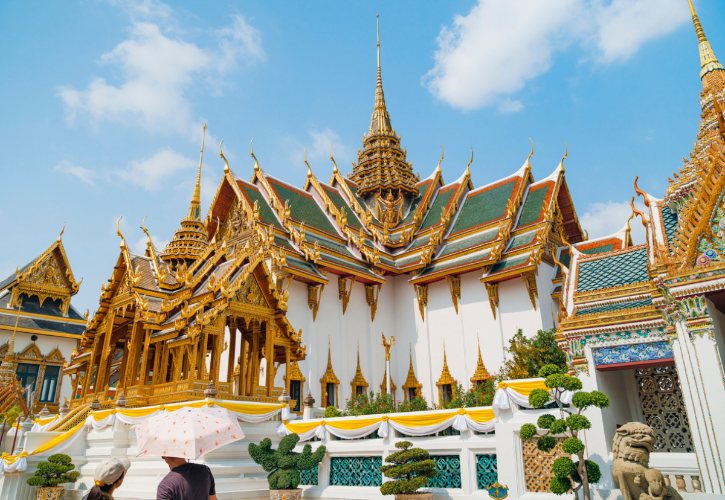
The Grand Palace isn’t just Bangkok’s most famous landmark. It’s the heart of Thailand. Golden spires rise into the sky, and every corner reflects stories of kings, faith, and national pride.
Built in 1782, this grand complex has long been the spiritual center of the country.
Though Thai kings no longer live here, it still hosts royal ceremonies and draws millions of visitors each year.
In this guide, you’ll find everything you need for your visit, from seeing the Emerald Buddha to practical tips on avoiding crowds and making the most of your time. 😊
1. Grand Palace Overview
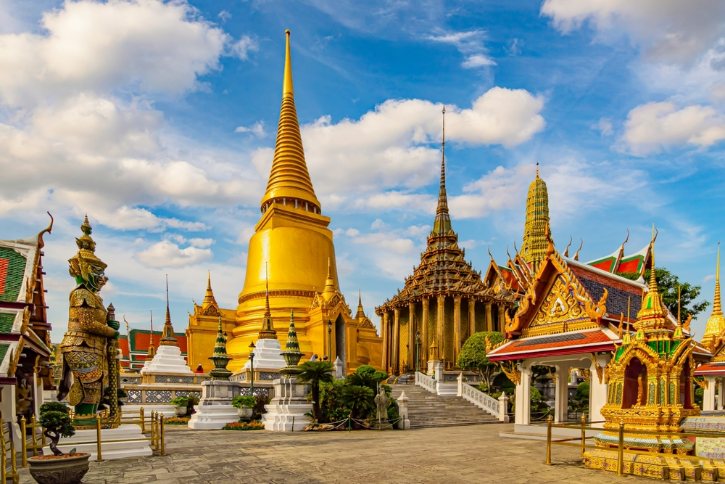
a. Why This Palace Matters
The Grand Palace has anchored Bangkok since King Rama I built it in 1782. He moved Thailand’s capital here from Thonburi and created a new dynasty that still reigns today.
The complex covers 218,000 square meters (about 54 acres) of prime riverside land. That’s roughly 40 football fields of temples, throne halls, and gardens to explore.
b. Living History, Not a Museum
This isn’t a dusty relic. King Rama X’s coronation took place here in 2019, and the palace hosts state functions throughout the year.
The Bureau of the Royal Household manages everything with meticulous care.
They work with the Fine Arts Department to preserve the buildings while keeping them functional for ceremonies.
2. Must-See Attractions Inside
a. Wat Phra Kaew (Temple of the Emerald Buddha)

This is Thailand’s holiest temple and your absolute priority. Built in 1783, it houses the famous Emerald Buddha that protects the nation.
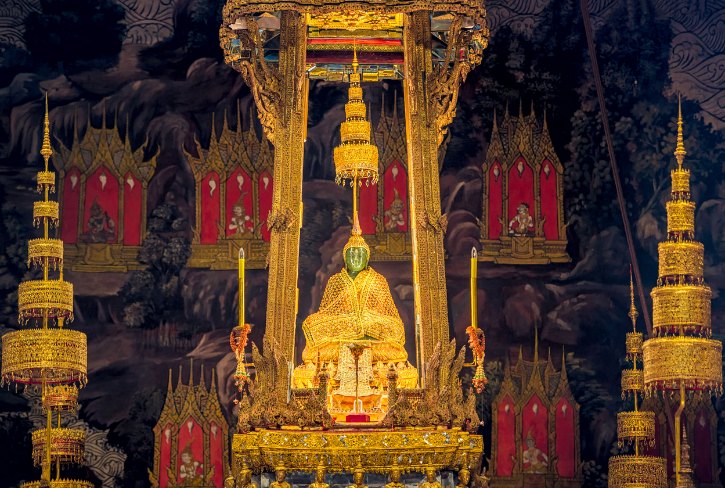
The Buddha itself is surprisingly small at just 66 cm tall, carved from green jade. You’ll spot it high on its golden throne, dressed in seasonal robes that only the King can change.
Visitor tips:
- Remove your shoes before entering
- Photography strictly forbidden inside
- Sit with feet pointing away from the Buddha
- Expect this area to be the most crowded
b. The Giant Yaksha Guards

You can’t miss these fierce demons standing 5 meters tall at the temple gates. Each colorful giant has its own identity, with unique faces and crown designs.
They’re characters from the Ramakien epic, Thailand’s national story. The green-faced Thotsakan and white-faced Sahassadeja are the most famous.
Trust me, these make for incredible photos.
c. The Royal Pantheon (Prasat Phra Dhepbidorn)

This elegant Khmer-style tower was meant to house the Emerald Buddha but proved too small. Now it honors all past kings of the Chakri dynasty with life-sized statues inside.
You can only enter on April 6th (Chakri Memorial Day). The rest of the year, admire its stunning exterior with golden spires and mythical creatures at the base.
d. Phra Mondop (Royal Library)

This glittering pavilion stores sacred Buddhist scriptures on palm leaves. The entire building sparkles with green and gold glass mosaics that catch the light beautifully.
Look for the stone lions and serpent guards at each doorway. While you can’t go inside, walking around this jewel box of a building reveals incredible details.
e. The Golden Chedi (Phra Si Ratana)

King Rama IV built this Sri Lankan-style stupa in the 1850s to house Buddha relics. It’s the tallest structure on the Upper Terrace and shines like a beacon.
The surface is covered in Italian gold mosaic tiles that are absolutely dazzling in morning sunlight. This is where you’ll likely take your favorite photos of the complex.
f. Model of Angkor Wat

Here’s something unexpected. King Rama IV wanted to move the actual Angkor Wat temple from Cambodia to Bangkok in the 1860s.
When that proved impossible, he commissioned this detailed stone model instead.
It sits quietly on the terrace, a fascinating reminder of Thailand’s historical influence over Cambodia.
g. Chakri Maha Prasat Hall

Nicknamed “the farang (foreigner) with a Thai hat”, this throne hall perfectly captures King Rama V’s modernization strategy. The body is Italian Renaissance, but Thai spires crown the top.
Built in 1882, it still hosts state banquets today. You can admire the facade and watch the changing of guards every two hours in the courtyard.
h. Dusit Maha Prasat Hall

This is pure Thai architecture at its finest. Built by Rama I in 1790, its graceful multi-tiered roof represents Mount Meru, center of the Buddhist universe.
Today it serves as the lying-in-state hall for royal family members. The mother-of-pearl throne inside is exquisite if the hall is open during your visit.
i. The Ramakien Murals

These painted stories wrap around the entire temple complex in 178 panels.
They tell Thailand’s national epic about good conquering evil, stretching over 2 kilometers in total.
Start opposite the Spired Hall and walk clockwise to follow the story. Even without knowing the plot, the vivid battle scenes and golden details are mesmerizing.
3. Planning Your Visit

a. Opening Hours and Tickets
- Daily Schedule: 8:30 AM to 4:30 PM (last entry at 3:30 PM)
- Ticket Price: ฿500 for foreign adults
- Free Entry: Children under 120 cm height, Thai citizens with ID
Your ticket includes:
- Grand Palace and Wat Phra Kaew
- Queen Sirikit Museum of Textiles (on-site)
b. Dress Code (Strictly Enforced!)

Guards won’t let you in if your outfit doesn’t meet the dress code. Make sure you’re dressed appropriately before visiting, as they’re quite strict with the rules.
Men must wear:
- Long pants covering ankles
- Shirts with sleeves (t-shirts are fine)
Women must wear:
- Covered shoulders (actual sleeves, not just a scarf)
- Skirts or pants past the knees
- No tight leggings or see-through fabrics
Pro tip: Dress appropriately before you arrive. Street vendors sell cover-up clothes, but they’re overpriced and you’ll waste time shopping.
c. Getting There
Option 1 – BTS + Boat (Most Scenic):
- Take BTS Silom Line to Saphan Taksin Station
- Walk to Sathorn Pier
- Catch Orange Flag Express Boat to Tha Chang Pier
- Walk 3 minutes to palace entrance
Option 2 – MRT (Most Direct):
- Take Blue Line to Sanam Chai Station
- Exit 1, then walk 15 minutes
Option 3 – Taxi/Grab:
- Direct ride from central Bangkok
- Always insist on meter or use Grab app for fixed price
4. Nearby Attractions
a. Wat Pho (10-minute walk)
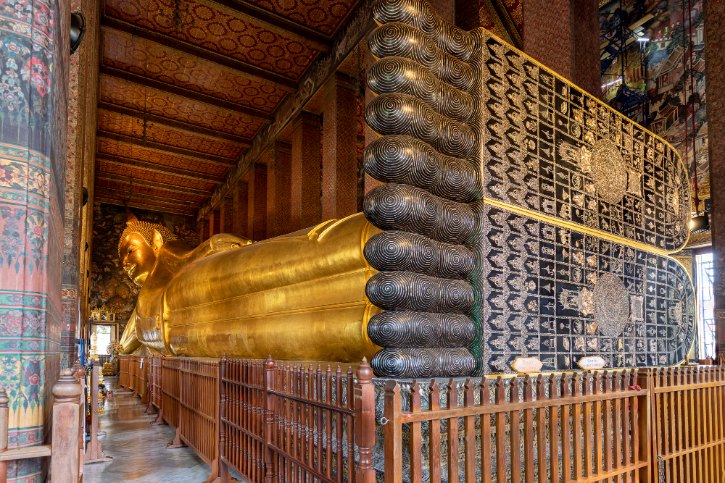
Home to the giant Reclining Buddha, this temple is literally next door. It’s less formal than the Grand Palace and offers affordable Thai massages.
Walk south from the palace exit along Sanam Chai Road. You’ll see the entrance in about 10 minutes.
b. Wat Arun (5-minute ferry ride)
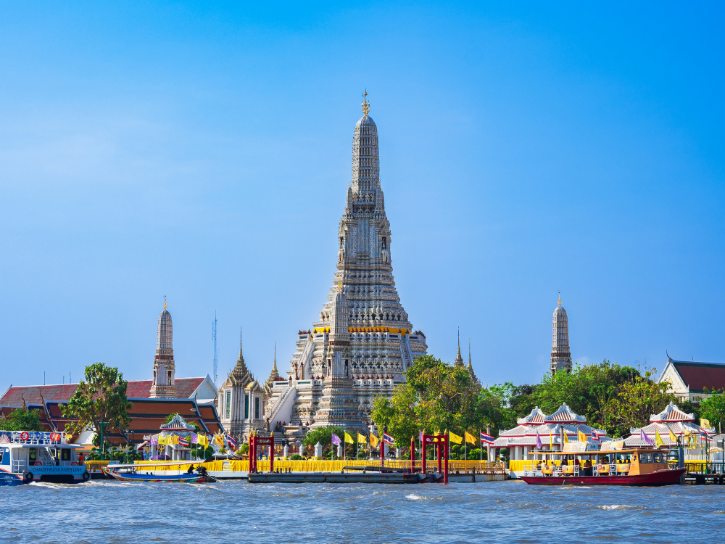
The iconic Temple of Dawn sits across the river. Head to Tha Tien Pier behind Wat Pho and catch the cross-river ferry for just ฿5.
Climb the central tower for stunning views back toward the Grand Palace. Best visited in late afternoon when the tiles glow in golden light.
5. Essential Tips and Warnings
a. Beat the Crowds
Arrive by 8:15 AM to be first in line. The initial hour (8:30-9:30 AM) offers peaceful exploration before tour buses arrive at 10 AM.
Weekdays are slightly quieter than weekends.
b. The Famous “Palace Closed” Scam
If anyone approaches you on the street saying the palace is closed for a “ceremony” or “Buddhist holiday”, they’re lying. This scam is as old as the palace itself.
These scammers want to divert you to gem shops where they earn commissions. Just smile, say “no thank you”, and keep walking to the entrance.
Remember: The palace rarely closes. Check the official website if concerned, but trust the crowds heading inside, not random strangers on the sidewalk.
c. Stay Comfortable
Bangkok’s sun is brutal. Bring water, wear a hat, and apply sunscreen before entering.
The new underground tunnels offer air-conditioning and clean restrooms. Use them to cool down if you’re overheating.
d. Photography Rules
You can photograph everything outside, but never inside the Emerald Buddha chapel. Guards will make you delete photos if they catch you.
No drones allowed anywhere on palace grounds. Leave yours at the hotel.
e. Show Respect
You’re in Thailand’s most sacred space. Keep voices low, dress modestly, and never point your feet at Buddha images.
Remove hats and sunglasses before entering any building. Follow the lead of Thai visitors if you’re unsure about proper behavior.
6. Making the Most of Your Visit
Plan on spending 1.5 to 2 hours exploring. Start with Wat Phra Kaew (the Emerald Buddha temple) while you’re fresh, then move to the palace buildings.
The complex is one-way only. Once you exit near the textile museum, you cannot re-enter with the same ticket.
Consider combining your visit with Wat Pho and Wat Arun for a perfect half-day temple tour. Most visitors do exactly this route, finishing with sunset at Wat Arun.
Audio guides are available for ฿200 if you want detailed commentary. They offer good value, especially if you’re interested in the historical details.
My Final Thoughts
Yes, the Grand Palace gets crowded. Yes, it’s touristy. But standing before the Emerald Buddha or gazing up at those golden spires, you’ll understand why this remains Bangkok’s unmissable attraction.
The palace represents everything magnificent about Thai culture. Give it the time and respect it deserves, and you’ll leave with memories that last a lifetime.

